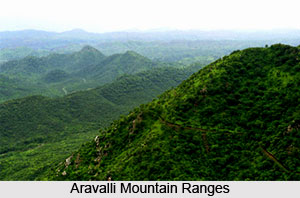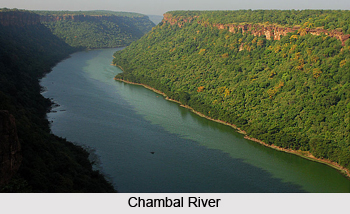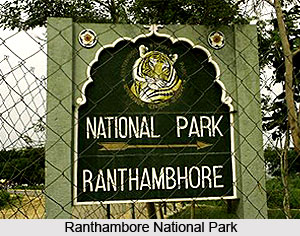 Geography of Ranthambore Tiger Reserve in Rajasthan comprises distinct areas with mere narrow corridors linking them to the core, Ranthambore National Park. These are mainly, the Ranthambore National Park, Kela Devi Sanctuary and Sawai Man Singh Sanctuary. It also includes dry deciduous Anogeissus Pendula forests. Such forests are found all along the north and central regions of Aravalli mountain ranges. However, in the last few decades they have been badly degraded. In Ranthambore the bio diversity is made even richer by the intrusion of the Vindhyan hill system.
Geography of Ranthambore Tiger Reserve in Rajasthan comprises distinct areas with mere narrow corridors linking them to the core, Ranthambore National Park. These are mainly, the Ranthambore National Park, Kela Devi Sanctuary and Sawai Man Singh Sanctuary. It also includes dry deciduous Anogeissus Pendula forests. Such forests are found all along the north and central regions of Aravalli mountain ranges. However, in the last few decades they have been badly degraded. In Ranthambore the bio diversity is made even richer by the intrusion of the Vindhyan hill system.
In the past years, the areas surrounding the Ranthambore Tiger Reserve have been totally deforested and as a result, the tiger reserve is now considered as an ecological island surrounded by farmlands and overgrazed pastures. It is home to over 40 species of mammals, 320 species of birds, over 40 species of reptiles and over 300 species of plants. The Chambal River forms a natural boundary of the Ranthambore National Park towards the east. To the northeast of the Ranthambore national park, flows Banas River, a tributary of Chambal River. Across the river Banas located is the Kela Devi sanctuary, while the Sawai Man Singh wildlife sanctuary lies to the south of this national park. Both these sanctuaries, along with the Ranthambore National Park, are part of the Ranthambore Tiger Reserve. Today, this Project Tiger Reserve spans over 1334 sq km of area, of which 274.5 sq km is the Ranthambore National Park.
 Ranthambore Tiger Reserve is also a crucial link and wildlife corridor between chains of Protected Areas from Dholpur District in the north-east to the Kota district in the south-west. In this chain of protected areas, not only does Ranthambore have the highest bio-diversity but it is the only protected area that has large and viable populations of fauna. This tiger reserve is also an invaluable watershed for the surrounding areas, a fact that is made more significant considering that the surrounding areas have low annual rainfall. Ranthambore Tiger Reserve is an important catchment area for River Chambal, which in turn, is an important river in the Gangetic system. The reserve is also the most important catchment for a large number of reservoirs that surround it. It also plays a very important role in recharging the ground water of the area. These reservoirs and the ground water are the only source of water for the entire surrounding area.
Ranthambore Tiger Reserve is also a crucial link and wildlife corridor between chains of Protected Areas from Dholpur District in the north-east to the Kota district in the south-west. In this chain of protected areas, not only does Ranthambore have the highest bio-diversity but it is the only protected area that has large and viable populations of fauna. This tiger reserve is also an invaluable watershed for the surrounding areas, a fact that is made more significant considering that the surrounding areas have low annual rainfall. Ranthambore Tiger Reserve is an important catchment area for River Chambal, which in turn, is an important river in the Gangetic system. The reserve is also the most important catchment for a large number of reservoirs that surround it. It also plays a very important role in recharging the ground water of the area. These reservoirs and the ground water are the only source of water for the entire surrounding area.
Geography of Ranthambore Tiger Reserve includes mostly rugged and hilly terrains. The hills to the northwest of fault-line are the Aravalli ranges and typically have ridges on one side and gentle slope on the other. This Aravalli tract is highly undulating except for a few small plateaus and some small valleys. These valleys are teeming with wildlife and are the richest wildlife areas in the entire reserve. The highest point of this tract is Gazella peak, 507 metres above the mean sea level. The lowest altitude of this tract is 244 metres at Bodal. Streams flowing in northern tract form the catchment of Banas River and streams flowing in southern tract drain directly in Chambal River. Most of the streams are very short lived but the streams facing sharp ridges are considered as perennial, as the folded impervious rocky strata beneath, does not permit the water to percolate.
 The hills south west of this tiger reserve are the Vindhyas. The sand stone beds of these hills are flat-topped. At places, small and short-lived streams have eroded deep, long and narrow gorges. The ravines are prominent feature of both the rivers, the Chambal and the Banas. These ravines are formed due to sandy nature of the soil along the banks of the rivers. Along the Chambal, the ravines are as deep as 50 metres and extend up to 8 kms in length. The ravines are very important for the lesser fauna.
The hills south west of this tiger reserve are the Vindhyas. The sand stone beds of these hills are flat-topped. At places, small and short-lived streams have eroded deep, long and narrow gorges. The ravines are prominent feature of both the rivers, the Chambal and the Banas. These ravines are formed due to sandy nature of the soil along the banks of the rivers. Along the Chambal, the ravines are as deep as 50 metres and extend up to 8 kms in length. The ravines are very important for the lesser fauna.
Ranthambore Tiger Reserve, with its sub-tropical dry climate, has three very well defined seasons - summers, winters and monsoons. Winter generally starts from November and lasts till February. Summers start during the end of March and last through the months of April, May and June. During this season the days are very hot and dry. During May and June the maximum day temperature crosses 40 degree Centigrade. During the day, hot and dry winds blow. Further, the maximum day temperature often crosses 45 degrees Celsius in May and June, when the relative humidity is at its lowest. The monsoons or the rainy season lasts from July to September. This season is warm and humid, with one or two short thundershowers a week. The average annual rainfall is 800 mm and there is an average of 38 rainy days per year. The night temperature stays below 10 degrees Centigrade, while the day temperature remains around 20 degree Centigrade mark during the winter season.
Further, the main species of flora and fauna found in Ranthambore Tiger Reserve are Raunj, Goya, Chhela, Vad, Amaltas, Gurjan, Siris Saintha, Gular, Tendu, Tiger, Leopard, Caracal, Ratel, Jungle Cat, Chital, Sambar, Blue Bull, Chinkara, Sloth Bear, Wild Boar, Jackal, Striped Hyena, Langur, fox and more.



















